Timing of Paleozoic Exhumation and Deformation of the High-Pressure Vestgӧtabreen Complex at the Motalafjella Nunatak, Svalbard
Abstract
:1. Introduction
2. Geological Background
3. Vestgӧtabreen Complex Samples
4. In situ White Mica 40Ar/39Ar Geochronology
4.1. Methods
4.2. Results
5. Monazite Th-U-Total Pb Geochronology
5.1. Methods
5.2. Results
6. Discussion
6.1. Extraneous 40Ar and Cooling Recorded in the Upper Unit White Mica
6.2. Extraneous Pb in Monazite
6.3. Juxtaposition of the Upper and Lower Units Recorded by White Mica
6.4. Silurian to Devonian Caledonian Thrusting Recorded by White Mica and Monazite
6.5. Possible Ellesmerian Tectonothermal Overprint
7. Tectonic Correlations within the Caledonian Orogeny
8. Conclusions
Supplementary Materials
Author Contributions
Funding
Acknowledgments
Conflicts of Interest
Appendix A
| In-Situ White Mica 40Ar/39Ar Populations. | ||||||||
|---|---|---|---|---|---|---|---|---|
| Population | ±2σ 1 | Fraction of Dataset | Number of Analyses for the Population | Weighted Average 2 | ±2σ 3 | MSWD | ±2σ 4 | UP 5 |
| Upper Unit (n = 41) | ||||||||
| 493.3 | 1.5 | 0.14 | 5.74 | 493.1 | 1.7 | 4.2 | 4.5 | 7.3 |
| 476.3 | 0.7 | 0.69 | 28.29 | 476.2 | 0.71 | 4.1 | 1.5 | 2.3 |
| 439.8 | 1.5 | 0.17 | 6.97 | 439.8 | 1.5 | 7 | 5 | 7.4 |
| Lower Unit (n = 42) | ||||||||
| 454.4 | 0.8 | 0.36 | 15.12 | 454.4 | 0.8 | 15 | 3.3 | 6.1 |
| 426.4 | 0.92 | 0.36 | 15.12 | 426.3 | 0.92 | 15 | 3.8 | 3.8 |
| 398.1 | 1.2 | 0.21 | 8.82 | 398.1 | 1.1 | 22 | 6.1 | 6.1 |
| 364.7 | 1.9 | 0.07 | 2.94 | 364.7 | 1.9 | 1.8 | 5.4 | 10.5 |
| Monazite Th-U-total Pb Populations | ||||||||
| SN18-05A (n = 55) | ||||||||
| 595.3 | 7.5 | 0.11 | 6.1 | 596.2 | 5.9 | 0.9 | 5.9 | 30.3 |
| 522.7 | 6.0 | 0.16 | 8.8 | 523.3 | 5.0 | 6.0 | 14.0 | 22.1 |
| 433.5 | 3.9 | 0.19 | 10.5 | 433.7 | 3.8 | 4.2 | 8.6 | 13.9 |
| 393.7 | 2.2 | 0.39 | 21.5 | 393.7 | 2.2 | 5.1 | 5.2 | 7.2 |
| 343.9 | 6.3 | 0.14 | 7.7 | 344.0 | 6.3 | 2.2 | 11.0 | 23.9 |
| SN18-06 (n = 28) | ||||||||
| 584.9 | 9.2 | 0.14 | 3.9 | 584.8 | 9.2 | 2.9 | 25.0 | 43.6 |
| 494.8 | 6.2 | 0.18 | 5.0 | 494.8 | 6.2 | 7.9 | 24.0 | 26.5 |
| 410.3 | 2.8 | 0.43 | 12.0 | 410.3 | 2.8 | 10.9 | 10.0 | 9.7 |
| 344.0 | 3.8 | 0.25 | 7.0 | 344.0 | 3.8 | 4.1 | 9.6 | 14.7 |
| SN18-12 (n = 28) | ||||||||
| 485.4 | 8.4 | 0.21 | 5.9 | 485.4 | 5.6 | 8.5 | 21.0 | 22.8 |
| 408.6 | 3.2 | 0.52 | 14.6 | 408.5 | 3.2 | 12.0 | 12.0 | 10.9 |
| 345.2 | 5.6 | 0.26 | 7.3 | 344.7 | 8.3 | 1.3 | 11.0 | 32.2 |
References
- Harland, W.B. The Geology of Svalbard; The Geological Society of London, Memoirs: London, UK, 1997; Volume 17, pp. 1–521. [Google Scholar]
- Gee, D.G.; Teben’kov, A.M. Svalbard: A fragment of the Laurentian margin. In The Neoproterozoic Timanide Orogen of Eastern Baltica; Gee, D.G., Pease, V., Eds.; The Geological Society of London, Memoirs: London, UK, 2004; Volume 30, pp. 191–206. [Google Scholar]
- Pease, V.; Drachev, S.; Stephenson, R.; Zhang, X. Arctic lithosphere—A review. Tectonophysics 2014, 628, 1–25. [Google Scholar] [CrossRef]
- Piepjohn, K.; von Gosen, W.; Tessensohn, F.; Reinhardt, L.; McClelland, W.C.; Dallmann, W.K.; Gaedicke, C.; Harrison, J.C. Tectonic map of the Ellesmerian and Eurekan deformation belts on Svalbard, North Greenland, and the Queen Elizabeth Islands (Canadian Arctic). Arktos 2015, 1, 12. [Google Scholar] [CrossRef] [Green Version]
- Gee, D.G.; Fossen, H.; Henriksen, N.; Higgins, A.K. From the Early Paleozoic Platforms of Baltica and Laurentia to the Caledonide Orogen of Scandinavia and Greenland. Episodes 2008, 31, 44–51. [Google Scholar] [CrossRef] [Green Version]
- Gee, D.G.; Juhlin, C.; Pascal, C.; Robinson, P. Collisional Orogeny in the Scandinavian Caledonides (COSC). GFF 2010, 132, 29–44. [Google Scholar] [CrossRef]
- Gee, D.G. Svalbard‘s Caledonian terranes reviewed. GFF 1986, 108, 284–286. [Google Scholar] [CrossRef]
- Gee, D.G.; Page, L.M. Caledonian terrane assembly on Svalbard: new evidence from 40Ar/39Ar dating in Ny Friesland. Am. J. Sci. 1994, 294, 1166–1186. [Google Scholar] [CrossRef]
- Friend, P.F.; Williams, B.P.J.; Ford, M.; Williams, E.A. Kinematics and dynamics of Old Red Sandstone basins. In New Perspectives on the Old Red Sandstone; Friend, P.F., Williams, B.P.J., Eds.; The Geological Society of London, Memoirs: London, UK, 2000; Volume 180, pp. 29–60. [Google Scholar]
- Manby, G.; Lyberis, N. Tectonic evolution of the Devonian Basin of northern Svalbard. Nor. Geol. Tidsskr. 1992, 72, 7–19. [Google Scholar]
- McCann, A.J. Deformation of the Old Red Sandstone of NW Spitsbergen links to the Ellesmerian and Caledoin orogenies. In New Perspectives on the Old Red Sandstone; Friend, P.F., Williams, B.P.J., Eds.; The Geological Society of London, Memoirs: London, UK, 2000; Volume 180, pp. 567–584. [Google Scholar]
- Piepjohn, K. The Svalbardian-Ellesmerian deformation of the Old Red Sandstone and the pre-Devonian basement in NW Spitsberg (Svalbard). In New Perspectives on the Old Red Sandstone; Friend, P.F., Williams, B.P.J., Eds.; The Geological Society of London, Memoirs: London, UK, 2000; Volume 180, pp. 585–601. [Google Scholar]
- Kośmińska, K.; Spear, F.; Majka, J.; Kośmińska, K. P–T–t metamorphic evolution of highly deformed metapelites from the Pinkie unit of western Svalbard using quartz-in-garnet barometry, trace element thermometry, P–T–X–M diagrams and monazite in-situ dating. In Proceedings of the European Geoscience Union, Vienna, Austria, 23–28 April 2017. Geophysical Research Abstracts 19, EGU2017-10469. [Google Scholar]
- Michalski, K.; Manby, G.; Nejbert, K.; Domańska-Siuda, J.; Burzyński, M. Using palaeomagnetic and isotopic data to investigate late to post-Caledonian tectonothermal processes within the Western Terrane of Svalbard. J. Geol. Soc. Lond. 2017, 174, 572–590. [Google Scholar] [CrossRef]
- Ohta, Y.; Hirajima, T.; Hiroi, Y. Caledonian high-pressure metamorphism in central western Spitsbergen. Geol. Soc. Am. Mem. 1986, 164, 205–216. [Google Scholar]
- Labrousse, L.; Elvevold, S.; Lepvrier, C.; Agard, P. Structural analysis of high-pressure metamorphic rocks of Svalbard: Reconstructing the early stages of the Caledonian orogeny. Tectonics 2008, 27, 1–22. [Google Scholar] [CrossRef]
- Harland, W.B. Caledonide Svalbard. In The Caledonian Orogen—Scandinavia and Related Areas; Gee, D.G., Sturt, B.A., Eds.; John Wiley & Sons, Inc.: Hoboken, NJ, USA, 1985; pp. 999–1016. [Google Scholar]
- Mazur, S.; Czerny, J.; Majka, J.; Manecki, M.; Holm, D.; Smyrak, A.; Wypych, A. A strike-slip terrane boundary in Wedel Jarlsberg Land, Svalbard, and its bearing on correlations of SW Spitsbergen with the Pearya terrane and Timanide belt. J. Geol. Soc. Lond. 2009, 166, 529–544. [Google Scholar] [CrossRef]
- Bazarnik, J.; Majka, J.; McClelland, W.C.; Strauss, J.V.; Kośmińska, K.; Piepjohn, K.; Elvevold, S.; Czupyt, Z.; Mikuš, T. U–Pb zircon dating of metaigneous rocks from the Nordbreen Nappe of Svalbard’s Ny-Friesland suggests their affinity to Northeast Greenland. Terra Nov. 2019, 31, 518–526. [Google Scholar] [CrossRef]
- Craddock, C.; Hauser, E.C.; Maher, H.D.; Sun, A.Y.; Guo-Qiang, Z. Tectonic evolution of the west Spitsbergen Fold Belt. Tectonophysics 1985, 114, 193–211. [Google Scholar] [CrossRef]
- Dallmann, W.K. Multiphase tectonic evolution of the Sorkapp-Hornsund mobile zone (Devonian, Carboniferous, Tertiary), Svalbard. Nor. Geol. Tidsskr. 1992, 72, 49–66. [Google Scholar]
- Ohta, Y. Blue schists from Motalafjella, western Spitsbergen. Nor. Polarinst. Skr. 1979, 167, 171–210. [Google Scholar]
- Kośmińska, K.; Majka, J.; Mazur, S.; Krumbholz, M.; Klonowska, I.; Manecki, M.; Czerny, J.; Dwornik, M. Blueschist facies metamorphism in Nordenskiöld Land of west-central Svalbard. Terra Nov. 2014, 26, 377–386. [Google Scholar] [CrossRef]
- Horsfield, W.T. Glaucophane Schists of Caledonian age from Spitsbergen. Geol. Mag. 1972, 109, 29–36. [Google Scholar] [CrossRef]
- Kanat, L.; Morris, A. A Working Stratigraphy for Central Western Oscar Il Land, Spitsbergen; Norsk Polarinstitut: Tromsø, Norway, 1988; Volume 190, 24p. [Google Scholar]
- Ohta, Y.; Krasil’čšikov, A.A.; Lepvrier, C.; Teben’kov, A.M. Northern continuation of Caledonian high-pressure metamorphic rocks in central-western Spitsbergen. Polar Res. 1995, 14, 303–315. [Google Scholar] [CrossRef]
- Hirajima, T.; Hiroi, Y.; Ohta, Y. Lawsonite and pumpellyite from the Vestgotabreen formation in Spitsbergen. Nor. Geol. Tidsskr. 1984, 64, 267–273. [Google Scholar]
- Kanat, L.H. Jadeite from southern Oscar II Land, Svalbard. Mineral Mag. 1984, 48, 301–303. [Google Scholar] [CrossRef]
- Ohta, Y.; Hiroi, Y.; Hirajima, T. Additional evidence of pre-Silurian high-pressure metamorphic rocks in Spitsbergen. Polar Res. 1983, 1, 215–218. [Google Scholar] [CrossRef]
- Armstrong, H.A.; Nakrem, H.A.; Ohta, Y. Ordovician conodonts from the Bulltinden Formation, Motalafjella, central-western Spitsbergen. Polar Res. 1986, 4, 17–23. [Google Scholar] [CrossRef]
- Gasser, D.; Andresen, A. Caledonian terrane amalgamation of Svalbard: detrital zircon provenance of Mesoproterozoic to Carboniferous strata from Oscar II Land, western Spitsbergen. Geol. Mag. 2013, 150, 1103–1126. [Google Scholar] [CrossRef]
- Scrutton, C.T.; Horsfield, W.T.; Harland, W.B. Silurian fossils from western Spitsbergen. Geol. Mag. 1976, 113, 519–523. [Google Scholar] [CrossRef]
- Hirajima, T.; Banno, S.; Hiroi, Y.; Ohta, Y. Phase petrology of eclogites and related rocks from the Motalafjella high-pressure metamorphic complex in Spitsbergen (Arctic Ocean) and its significance. Lithos 1988, 22, 75–97. [Google Scholar] [CrossRef]
- Agard, P.; Labrousse, L.; Elvevold, S.; Lepvrier, C. Discovery of Paleozoic Fe-Mg carpholite in Motalafjella, Svalbard Caledonides: A milestone for subduction-zone gradients. Geology 2005, 33, 761–764. [Google Scholar] [CrossRef] [Green Version]
- Bernard-Griffiths, J.; Peucat, J.J.; Ohta, Y. Age and nature of protoliths in the Caledonian blueschist-eclogite complex of western Spitsbergen: A combined approach using U–Pb, Sm–Nd and REE whole-rock systems. Lithos 1993, 30, 81–90. [Google Scholar] [CrossRef]
- Dallmeyer, R.D.; Peucat, J.J.; Hirajima, T.; Ohta, Y. Tectonothermal chronology within a blueschist-eclogite complex, west-central Spitsbergen, Svalbard: Evidence from 40Ar/39Ar and Rb–Sr mineral ages. Lithos 1990, 24, 291–304. [Google Scholar] [CrossRef]
- Schneider, D.A.; Faehnrich, K.; Majka, J.; Manecki, M. 40Ar/39Ar geochronologic evidence of Eurekan deformation within the West Spitsbergen Fold and Thrust Belt. In Circum-Arctic Structural Events: Tectonic Evolution of the Arctic Margins and Trans-Arctic Links with Adjacent Orogens; Piepjohn, K., Strauss, J.V., Reinhardt, L., McClelland, W.C., Eds.; Geological Society of America: Boulder, CO, USA, 2019; Volume 541, pp. 1–16. [Google Scholar]
- Kuiper, K.F.; Deino, A.; Hilgen, F.J.; Krijgsman, W.; Renne, P.R.; Wijbrans, J.R. Synchronizing Rock Clocks of Earth History. Geophys. Res. Lett. 2008, 320, 500–504. [Google Scholar] [CrossRef] [Green Version]
- Spell, T.L.; McDougall, I. Characterization and calibration of 40Ar/39Ar dating standards. Chem. Geol. 2003, 198, 189–211. [Google Scholar] [CrossRef]
- Dazé, A.; Lee, J.K.W.; Villeneuve, M. An intercalibration study of the Fish Canyon sanidine and biotite 40Ar/39Ar standards and some comments on the age of the Fish Canyon Tuff. Chem. Geol. 2003, 199, 111–127. [Google Scholar] [CrossRef]
- Steiger, R.H.; Jäger, E. Subcommission on geochronology: Convention on the use of decay constants in geo- and cosmochronology. Earth Planet. Sci. Lett. 1977, 36, 359–362. [Google Scholar] [CrossRef]
- Renne, P.R.; Norman, E.B. Determination of the half-life of 37Ar by mass spectrometry. Phys. Rev. C Nucl. Phys. 2001, 63, 473021–473023. [Google Scholar] [CrossRef]
- Renne, P.R.; Swisher, C.C.; Deino, A.L.; Karner, D.B.; Owens, T.L.; DePaolo, D.J. Intercalibration of standards, absolute ages and uncertainties in 40Ar/39Ar dating. Chem. Geol. 1998, 145, 117–152. [Google Scholar] [CrossRef]
- Roddick, J.C. High precision intercalibration of 40Ar-39Ar standards. Geochim. Cosmochim. Acta 1983, 47, 887–898. [Google Scholar] [CrossRef]
- Ross, J. Pychron v2.0.4-beta. 2017. Available online: https://github.com/NMGRL/pychron (accessed on 15 May 2014).
- Deino, A.L. Users Manual for Mass Spec. Version 7.961; Berkeley Geochronology Cente: Berkeley, CA, USA, 2013; Volume 1a, pp. 1–132. [Google Scholar]
- Sambridge, M.S.; Compston, W. Mixture modeling of multi-component data sets with application to ion-probe zircon ages. Earth Planet. Sci. Lett. 1994, 128, 373–390. [Google Scholar] [CrossRef]
- Grand’Homme, A.; Janots, E.; Seydoux-Guillaume, A.M.; Guillaume, D.; Magnin, V.; Hövelmann, J.; Höschen, C.; Boiron, M.C. Mass transport and fractionation during monazite alteration by anisotropic replacement. Chem. Geol. 2018, 484, 51–68. [Google Scholar] [CrossRef]
- Seydoux-Guillaume, A.-M.; Fougerouse, D.; Laurent, A.T.; Gardeś, E.; Reddy, S.M.; Saxey, D.W. Nanoscale resetting of the Th/Pb system in an isotopically-closed monazite grain: A combined atom probe and transmission electron microscopy study. Geo. Front. 2019, 10, 65–79. [Google Scholar] [CrossRef]
- Villa-Vialaneix, N.; Montel, J.-M.; Seydoux-Guillaume, A.-M. NiLeDAM: Monazite Datation for the NiLeDAM Team. R Package Version 0.1. 2013. Available online: http://niledam.r-forge.r-project.org (accessed on 12 June 2018).
- Spear, F.S.; Pyle, J.M.; Cherniak, D. Limitations of chemical dating of monazite. Chem. Geol. 2009, 266, 227–239. [Google Scholar] [CrossRef]
- Harrison, M.T.; Célérier, J.; Aikman, A.B.; Hermann, J.; Heizler, M.T. Diffusion of 40Ar in muscovite. Geochim. Cosmochim. Acta 2009, 73, 1039–1051. [Google Scholar] [CrossRef]
- Warren, C.J.; Hanke, F.; Kelley, S.P. When can muscovite 40Ar/39Ar dating constrain the timing of metamorphic exhumation? Chem. Geol. 2012, 291, 79–86. [Google Scholar] [CrossRef]
- Agard, P.; Yamato, P.; Jolivet, L.; Burov, E. Exhumation of oceanic blueschists and eclogites in subduction zones: Timing and mechanisms. Earth Sci. Rev. 2009, 92, 53–79. [Google Scholar] [CrossRef]
- Smye, A.J.; Warren, C.J.; Bickle, M.J. The signature of devolatisation: Extraneous 40Ar systematics in high-pressure metamorphic rocks. Geochim. Cosmochim. Acta 2013, 113, 94–112. [Google Scholar] [CrossRef]
- Uunk, B.; Brouwer, F.; ter Voorde, M.; Wijbrans, J. Understanding phengite argon closure using single grain fusion age distributions in the Cycladic Blueschist Unit on Syros, Greece. Earth Planet. Sci. 2018, 484, 192–203. [Google Scholar] [CrossRef]
- Warren, C.J.; Kelley, S.P.; Sherlock, S.C.; McDonald, C.S. Metamorphic rocks seek meaningful cooling rate: Interpreting 40Ar/39Ar ages in an exhumed ultra-high pressure terrane. Lithos 2012, 155, 30–48. [Google Scholar] [CrossRef]
- Majka, J.; Be’eri-Shlevin, Y.; Gee, D.G.; Czerny, J.; Frei, D.; Ladenberger, A. Torellian (c. 640 Ma) metamorphic overprint of Tonian (c. 950 Ma) basement in the Caledonides of southwestern Svalbard. Geol. Mag. 2014, 151, 732–748. [Google Scholar] [CrossRef]
- Rasmussen, B.; Fletcher, I.R.; McNaughton, N.J. Dating low-grade metamorphic events by SHRIMP U-Pb analysis of monazite in shales. Geology 2001, 29, 963–966. [Google Scholar] [CrossRef]
- Seydoux-Guillaume, A.-M.; Montel, J.-M.; Bingen, B.; Bosse, V.; de Parseval, P.; Paquette, J.-L.; Janots, E.; Wirth, R. Low-temperature alteration of monazite: Fluid mediated coupled dissolution-precipitation, irradiation damage, and disturbance of the U-Pb and Th-Pb chronometers. Chem. Geol. 2012, 330–331, 140–158. [Google Scholar] [CrossRef]
- Seydoux-Guillaume, A.M.; Bingen, B.; Bosse, V.; Janots, E.; Laurent, A.T. Transmission electron microscope imaging sharpens geochronological interpretation of zircon and monazite. In Microstructural Geochronology: Planetary Records Down to Atom Scale; Moser, D., Corfu, F., Reddy, S.M., Darling, J., Tait, K., Eds.; John Wiley & Sons, Inc.: Hoboken, NJ, USA, 2018; pp. 261–275. [Google Scholar]
- Williams, M.L.; Jercinovic, M.J.; Harlov, D.E.; Budzyn, B.; Hetherington, C.J. Resetting monazite ages during fluid-related alteration. Chem. Geol. 2011, 283, 218–225. [Google Scholar] [CrossRef]
- Janots, E.; Negro, F.; Brunet, F.; Goffé, B.; Engi, M.; Bouybaouène, M.L. Evolution of the REE mineralogy in HP-LT metapelites of the Sebtide complex, Rif, Morocco: Monazite stability and geochronology. Lithos 2006, 87, 214–234. [Google Scholar] [CrossRef]
- Gabudianu Radulescu, I.; Rubatto, D.; Gregory, C.; Compagnoni, R. The age of HP metamorphism in the Gran Paradiso Massif, Western Alps: A petrological and geochronological study of “silvery micaschists”. Lithos 2009, 110, 95–108. [Google Scholar] [CrossRef]
- Cosca, M.; Stunitz, H.; Bourgeix, A.-L.; Lee, J.P. 40Ar* loss in experimentally deformed muscovite and biotite with implications for 40Ar/39Ar geochronology of naturally deformed rocks. Geochim. Cosmochim. Acta 2011, 75, 7759–7778. [Google Scholar] [CrossRef]
- Cossette, É.; Schneider, D.A.; Warren, C.J.; Grasemann, B. Lithological, rheological, and fluid infiltration control on 40Ar/39Ar ages in polydeformed rocks from the West Cycladic detachment system, Greece. Lithosphere 2015, 7, 189–205. [Google Scholar] [CrossRef] [Green Version]
- Egli, D.; Mancktelow, N.; Spikings, R. Constraints from 40Ar/39Ar geochronology on the timing of alpine shear zones in the mont blanc-aiguilles rouges region of the european alps. Tectonics 2017, 36, 730–748. [Google Scholar] [CrossRef]
- Kellett, D.A.; Warren, C.; Larson, K.P.; Zwingmann, H.; van Staal, C.R.; Rogers, N. Influence of deformation and fluids on Ar retention in white mica: Dating the Dover Fault, Newfoundland Appalachians. Lithos 2016, 254, 1–17. [Google Scholar] [CrossRef]
- Kramar, N.; Cosca, M.A.; Hunziker, J.C. Heterogeneous 40Ar* distributions in naturally deformed muscovite: in situ UV-laser ablation evidence for microstructurally controlled intragrain diffusion. Earth Planet Sci. Lett. 2001, 192, 377–388. [Google Scholar] [CrossRef]
- Mulch, A.; Cosca, M.A. Recrystallization or cooling ages: In situ UV-laser 40Ar/39Ar geochronology of muscovite in mylonitic rocks. J. Geol. Soc. Lond. 2004, 161, 573–582. [Google Scholar] [CrossRef] [Green Version]
- Root, D.; Corfu, F. U-Pb geochronology of two discrete Ordovician high-pressure metamorphic events in the Seve Nappe Complex, Scandinavian Caledonides. Contrib. Mineral. Petrol. 2012, 163, 769–788. [Google Scholar] [CrossRef]
- Dallmeyer, R.D.; Stephens, M.B. Chronology of eclogite retrogression within the Seve Nappe Complex, Råvvejaure, Sweden: Evidence from 40Ar/39Ar mineral ages. Geol. Runschau 1991, 80, 729–743. [Google Scholar] [CrossRef]
- Stephens, M.B.; Van Roermund, H.L.M. Occurrence of glaucophane and crossite in eclogites of the Seve nappes, southern Norrbotten Caledonides, Sweden. Nor. Geol. Tidsskr. 1984, 64, 155–163. [Google Scholar]
- Pettersson, C.H.; Pease, V.; Frei, D. Detrital zircon U–Pb ages of Silurian–Devonian sediments from NW Svalbard: A fragment of Avalonia and Laurentia? J. Geol. Soc. Lond. 2010, 167, 1019–1032. [Google Scholar] [CrossRef]
- Harland, W.B.; Wright, N.J. Alternative hypothesis for the pre-Carboniferous evolution of Svalbard. Nor. Polarinst. Skr. 1979, 167, 89–117. [Google Scholar]
- Ohta, Y.; Dallmeyer, R.D.; Peucat, J.J. Caledonian terranes in Svalbard. Geol. Soc. Am. Spec. Pap. 1989, 230, 1–16. [Google Scholar]
- McClelland, W.C.; Malone, S.J.; von Gosen, W.; Piepjohn, K.; Läufer, A. The timing of sinistral displacement of the Pearya Terrane along the Canadian Arctic Margin. Z. Dtsch. Ges. Geowiss. 2012, 163, 251–259. [Google Scholar] [CrossRef]
- Trettin, H.P. Pearya: A composite terrane with Caledonian affinities in northern Ellesmere Island. Can. J. Earth Sci. 1987, 24, 224–245. [Google Scholar] [CrossRef]
- Von Gosen, W.; Piepjohn, K.; McClelland, W.C.; Läufer, A. The Pearya Shear Zone in the Canadian High Arctic: Kinematics and significance. Z. Dtsch. Ges. Geowiss. 2012, 163, 233–249. [Google Scholar] [CrossRef]
- Andréasson, P.-G.; Allen, A.; Aurell, O.; Boman, D.; Ekestubbe, J.; Goerke, U.; Lundgren, A.; Nilsson, P.; Sandelin, S. Seve terranes of the Kebnekaise Mts., Swedish Caledonides, and their amalgamation, accretion and affinity. GFF 2018, 140, 264–291. [Google Scholar] [CrossRef] [Green Version]
- Bender, H.; Glodny, J.; Ring, U. Absolute timing of Caledonian orogenic wedge assembly, Central Sweden, constrained by Rb-Sr multi-mineral isochron data. Lithos 2019, 344, 339–359. [Google Scholar] [CrossRef]
- Dallmeyer, R.D.; Gee, D.G. Polyorogenic 40Ar/39Ar Mineral Age Record in the Seve and Köli Nappes of the Gäddede Area, Northwestern Jämtland, Central Scandinavian Caledonides. J. Geol. 1988, 96, 181–198. [Google Scholar] [CrossRef]
- Dallmeyer, R.D. 40Ar/39Ar mineral age record of a polyorogenic evolution within the Seve and Köli nappes, Trøndelag, Norway. Tectonophysics 1990, 179, 199–226. [Google Scholar] [CrossRef]
- Majka, J.; Be’eri-Shlevin, Y.; Gee, D.G.; Ladenberger, A.; Claesson, S.; Konečny, P.; Klonowska, I. Multiple monazite growth in the Åreskutan migmatite: Evidence for a polymetamorphic Late Ordovician to Late Silurian evolution in the Seve Nappe Complex of west-central Jämtland, Sweden. J. Geosci. 2012, 57, 3–23. [Google Scholar] [CrossRef] [Green Version]
- Ohta, Y. Caledonian and precambrian history in Svalbard: A review, and an implication of escape tectonics. Tectonophysics 1994, 231, 183–194. [Google Scholar] [CrossRef]
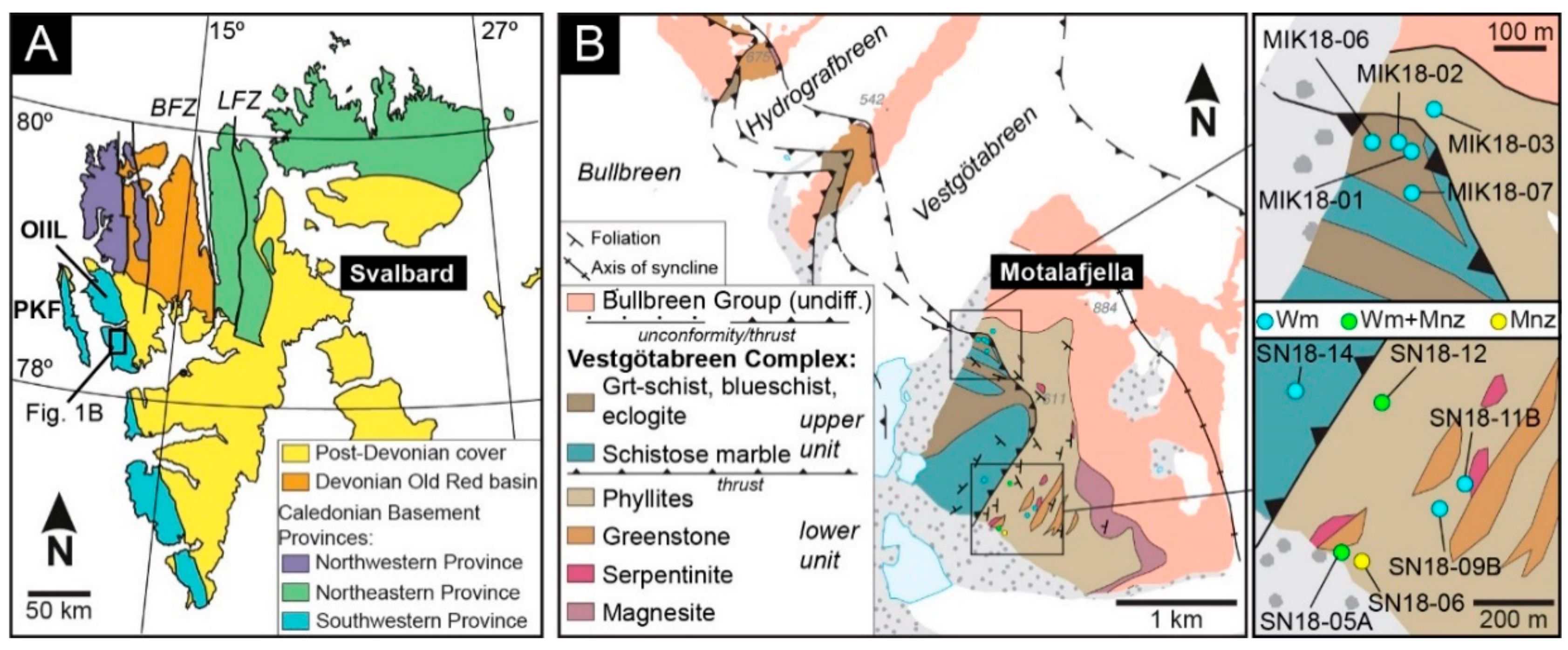

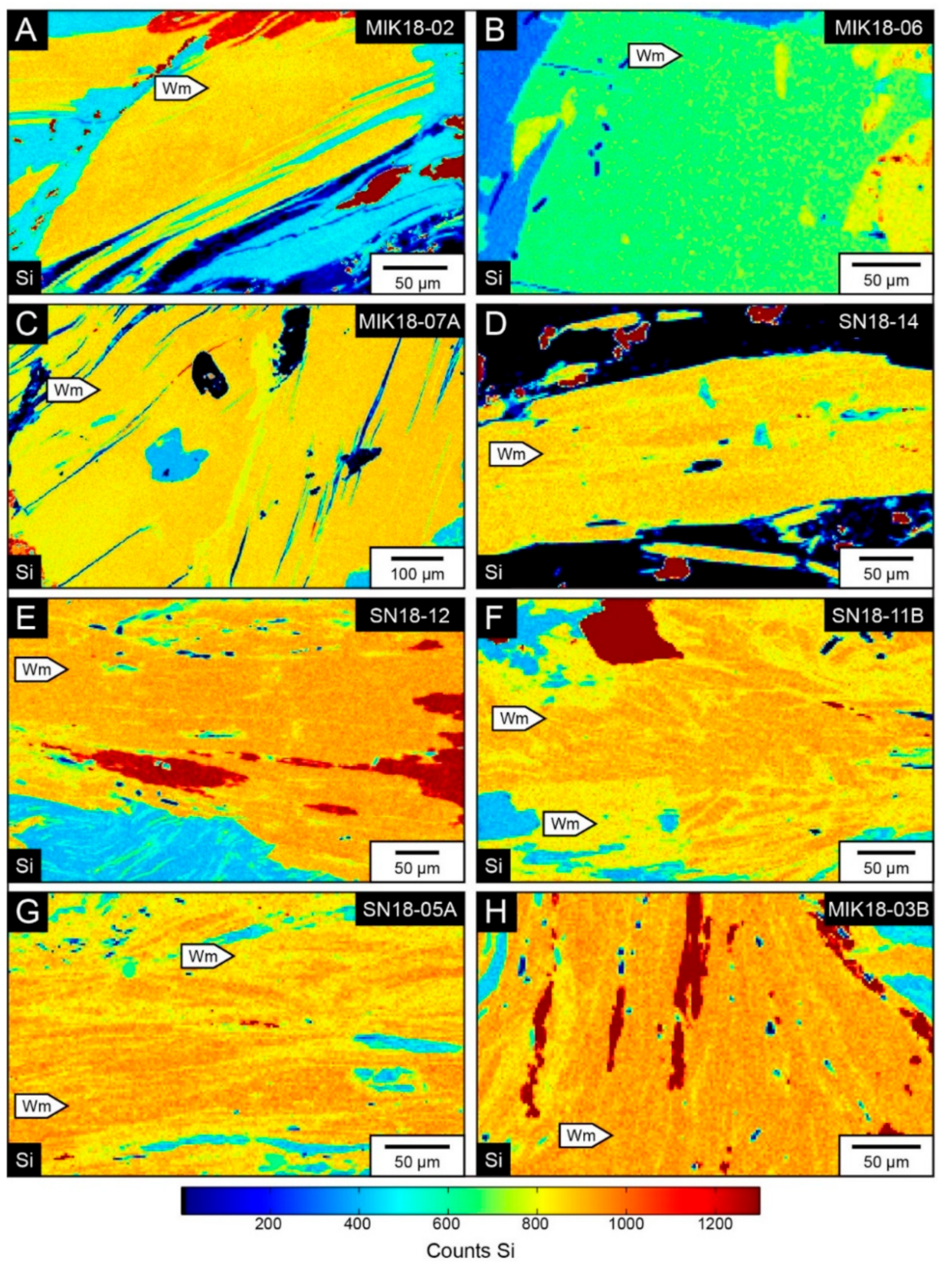
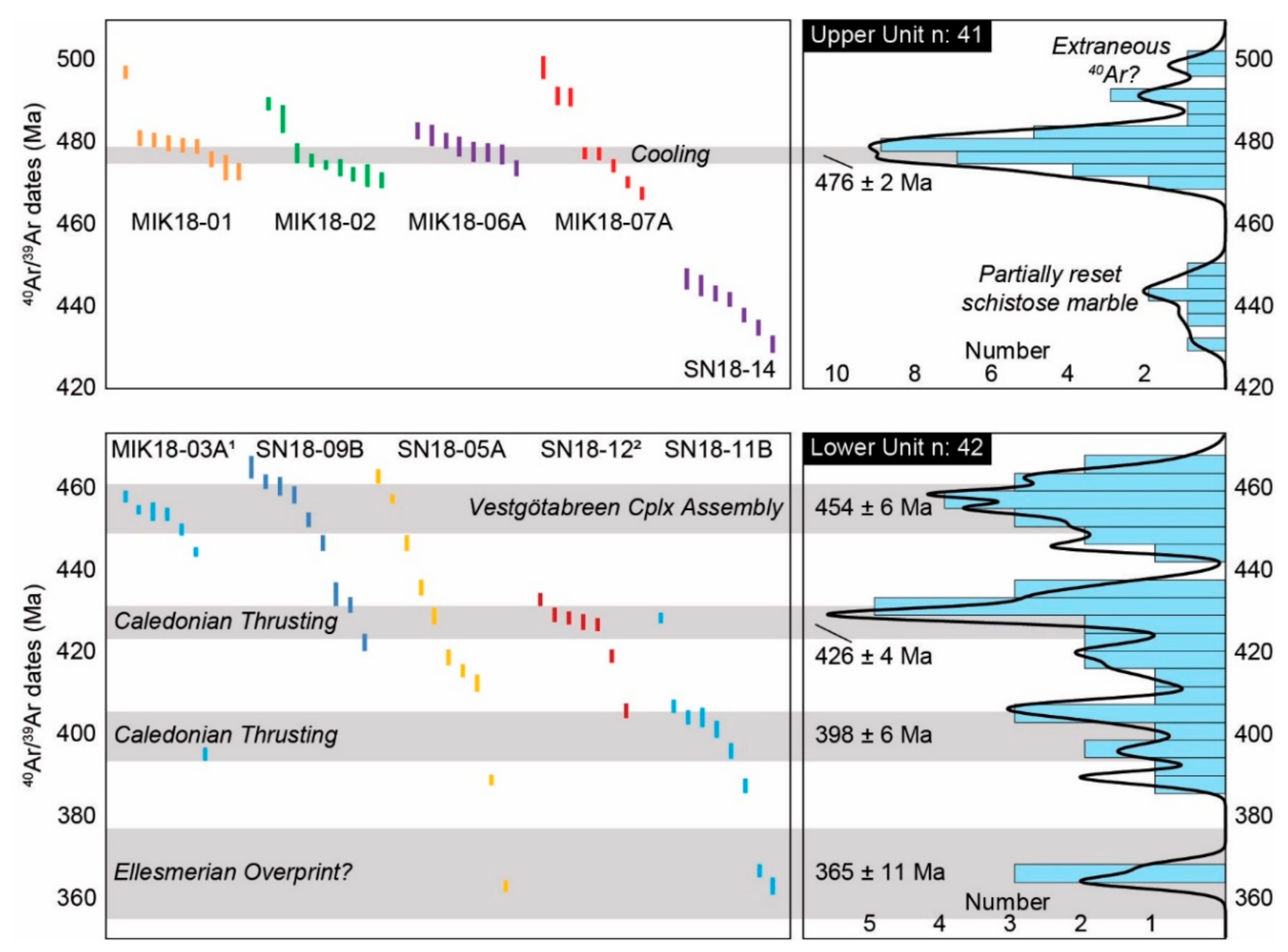
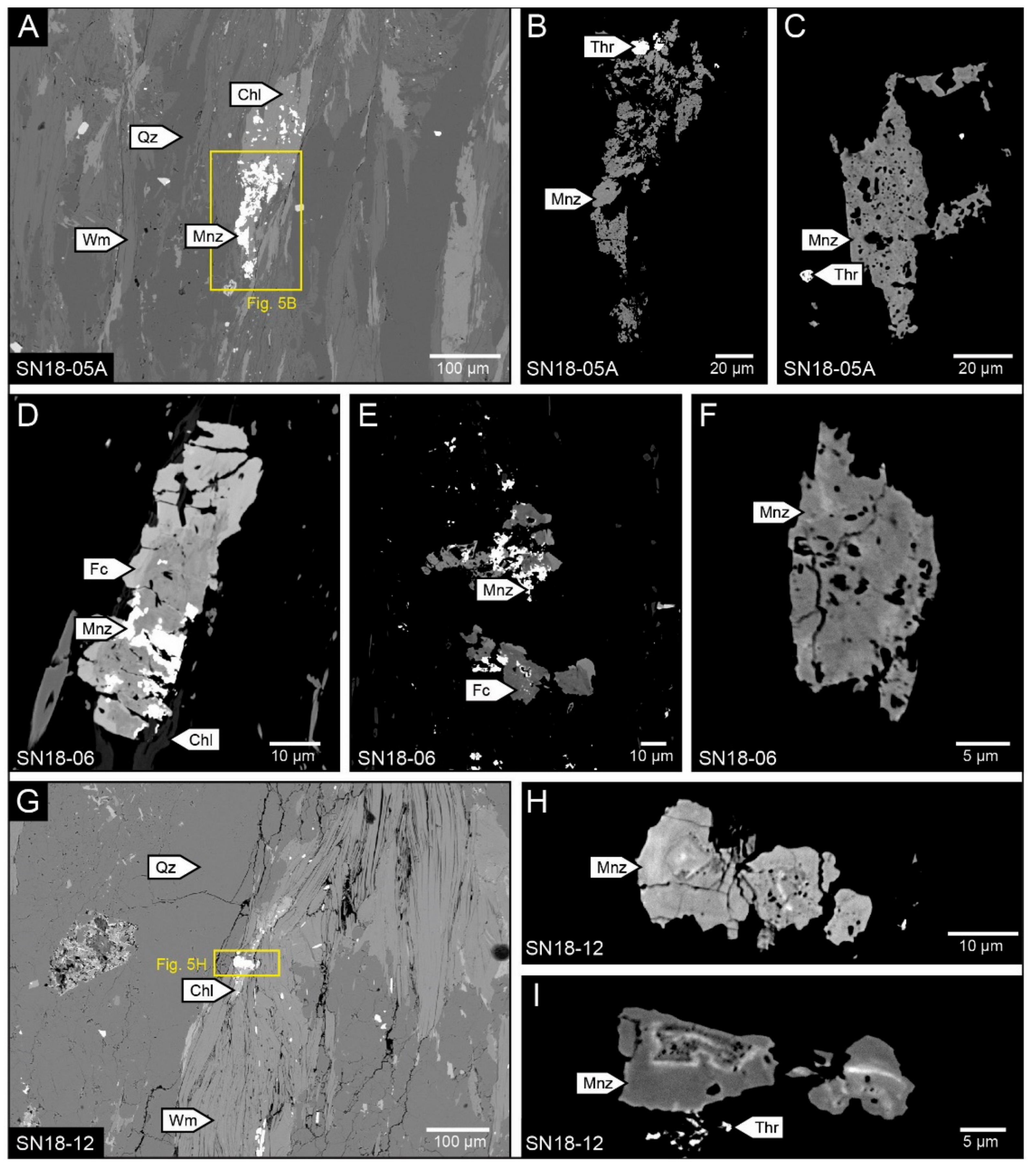
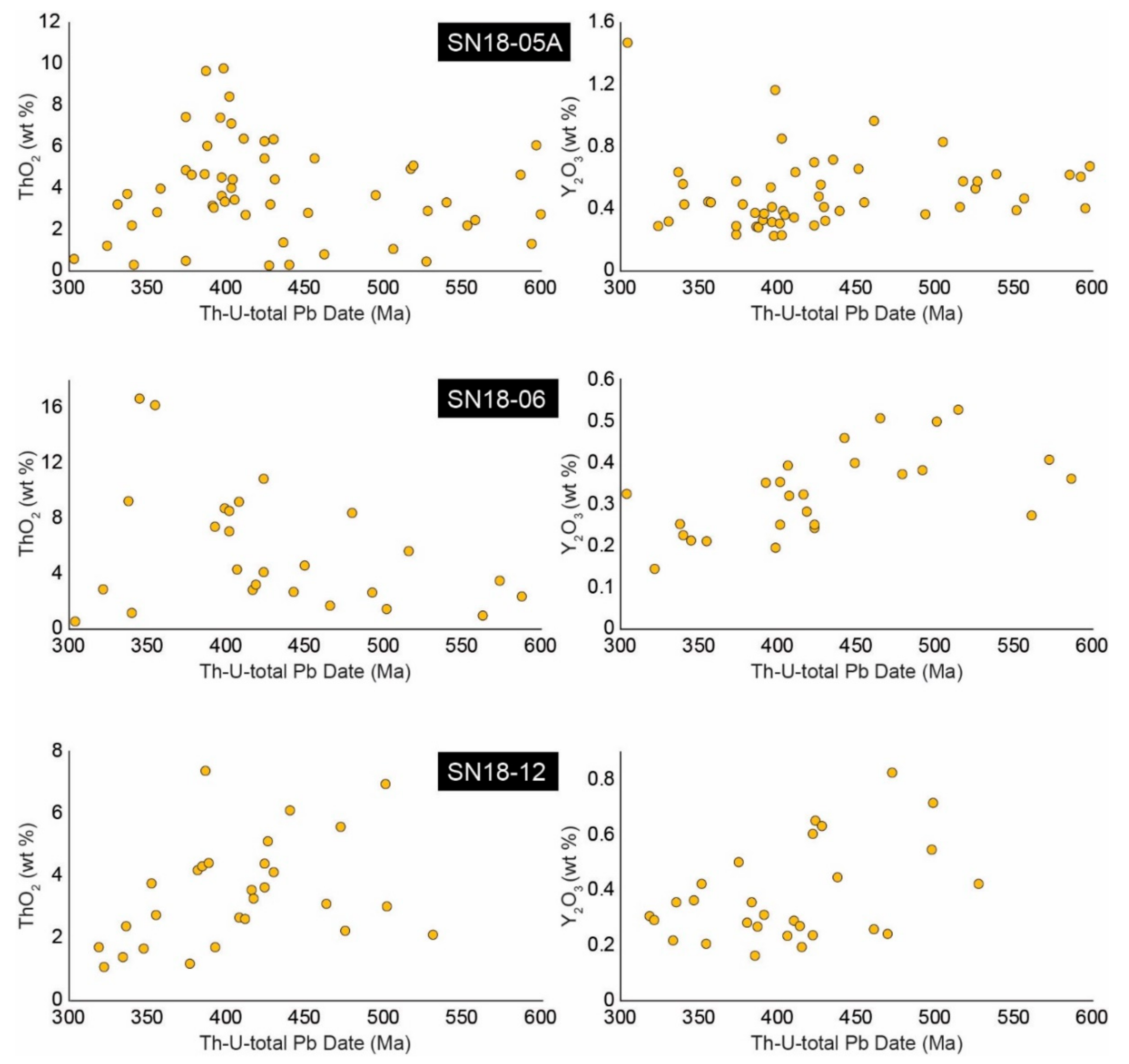
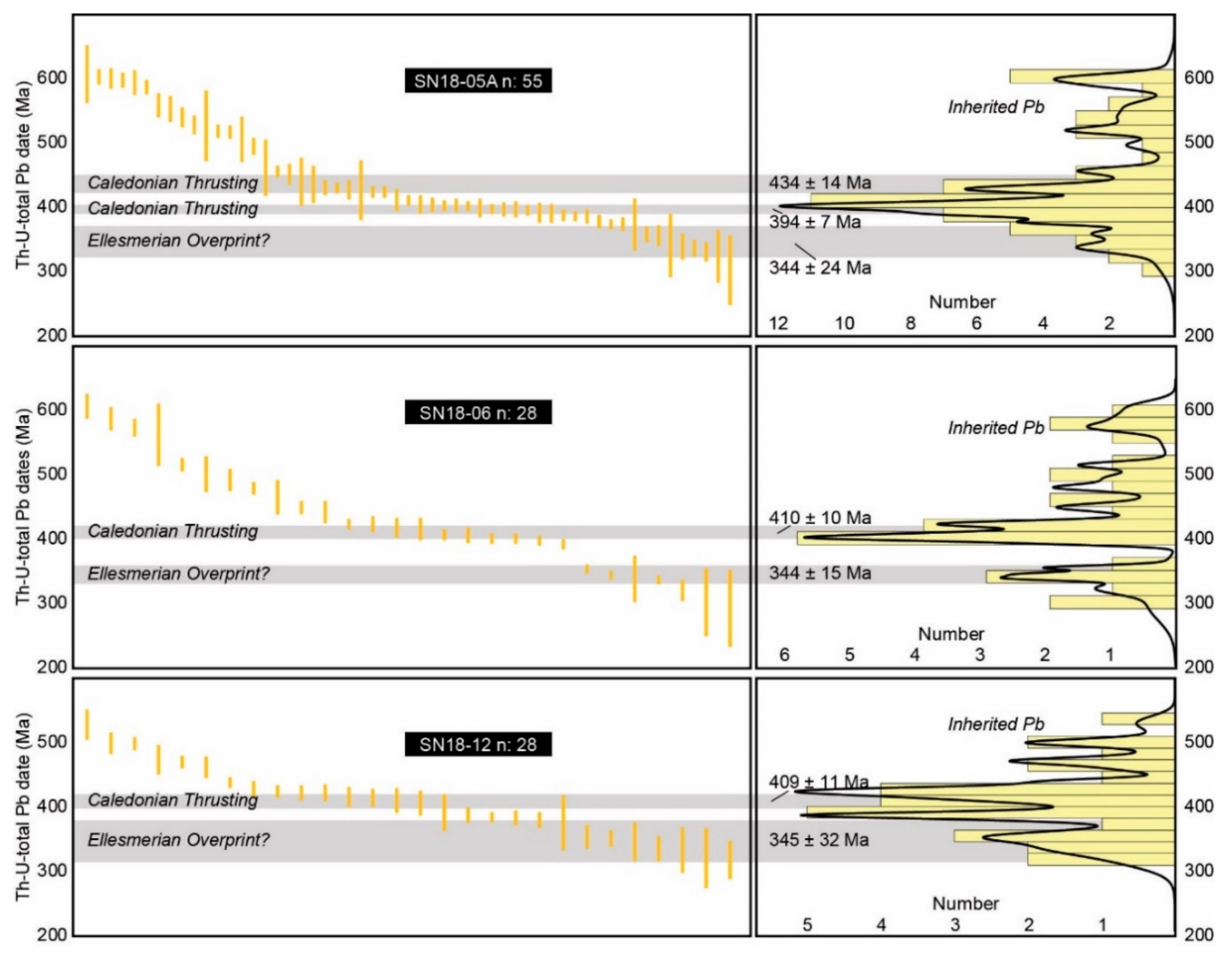

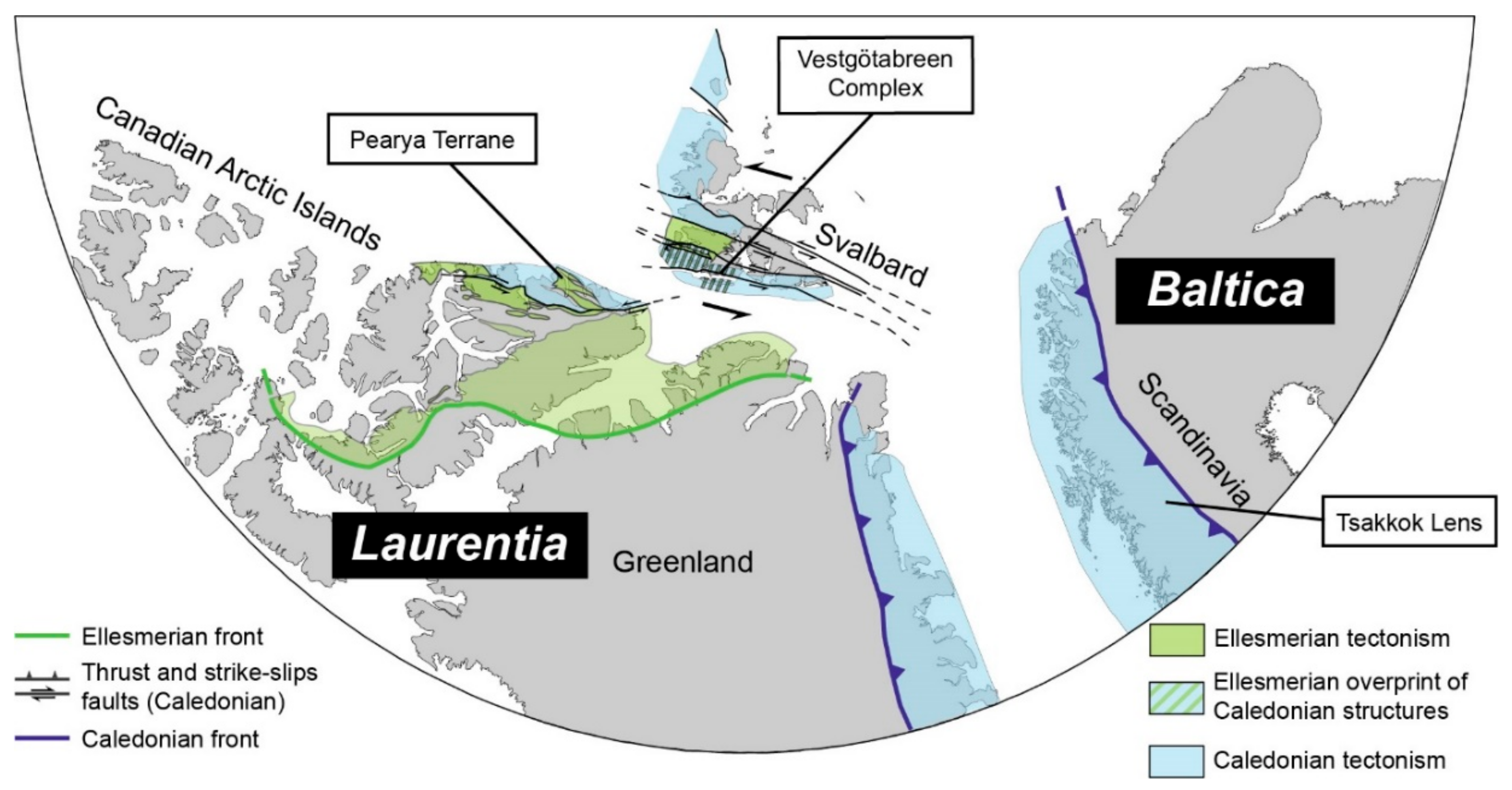
| Sample Name | Rock Type | Coordinates 1 | Number of Wm 2 Analyses | 40Ar/39Ar Date Range | 40Ar/39Ar Date Populations 3 | Number of Mnz 4 Analyses | Th-U-Total Pb Date Range | Th-U-Total Pb Date Populations 3 |
|---|---|---|---|---|---|---|---|---|
| Upper Unit | ||||||||
| MIK18-01 | Garnet-white mica schist | 78°26′23.09″N; 12°53′06.03″E | 9 | c. 498 Ma and c. 481–473 Ma | 493 ± 7 Ma; 476 ± 2 Ma; 440 ± 6 Ma | N/A | N/A | N/A |
| MIK18-02 | Well-foliated Blueschist | 78°26′28.08″N; 12°53′06.03″E | 9 | c. 490–471 Ma | N/A | N/A | N/A | |
| MIK18-06A | Well-foliated Lws-blueschist | 78°26′28.00″N; 12°52′55.06″E | 8 | c. 483–474 Ma | N/A | N/A | N/A | |
| MIK18-07A | Massive Lws-blueschist | 78°26′27.05″N; 12°53′10.08″E | 8 | c. 498–491 Ma and c. 478–468 Ma | N/A | N/A | N/A | |
| SN18-14 | Schistose marble | 78°25′33.38″N; 12°52′51.39″E | 7 | c. 447–431 Ma | N/A | N/A | N/A | |
| Lower Unit | ||||||||
| SN18-06 | Phyllite | 78°25′13.59"N; 12°53′35.31"E | N/A | N/A | N/A | 28 | c. 294–607 Ma | 585 ± 44 Ma; 495 ± 27 Ma; 410 ± 10 Ma; 344 ± 15 Ma |
| MIK18-03B | Brecciated white mica schist | 78°26′28.06"N; 12°53′14.04"E | 7 | c. 458–445 Ma and c. 395 Ma | 454 ± 6 Ma; 426 ± 4 Ma; 398 ± 6 Ma; 365 ± 11 Ma | N/A | N/A | N/A |
| SN18-05A | Phyllite | 78°25′14.33"N; 12°53′26.66"E | 10 | c. 463–363 Ma | 55 | c. 303–607 Ma | 595 ± 30 Ma; 523 ± 22 Ma; 434 ± 14 Ma; 394 ± 7 Ma; 344 ± 24 Ma | |
| SN18-09B | Retrogressed blueschist | 78°25′17.79"N; 12°54′16.84"E | 9 | c. 466–423 Ma | N/A | N/A | N/A | |
| SN18-11B | Phyllite | 78°25′20.93"N; 12°54′31.55"E | 9 | c. 429–364 Ma | N/A | N/A | N/A | |
| SN18-12 | Phyllite | 78°25′31.10"N; 12°53′46.48"E | 8 | c. 487 Ma and c. 433–406 Ma | 28 | c. 319–529 Ma | 485 ± 23 Ma; 409 ± 11 Ma; 345 ± 32 Ma |
© 2020 by the authors. Licensee MDPI, Basel, Switzerland. This article is an open access article distributed under the terms and conditions of the Creative Commons Attribution (CC BY) license (http://creativecommons.org/licenses/by/4.0/).
Share and Cite
Barnes, C.J.; Walczak, K.; Janots, E.; Schneider, D.; Majka, J. Timing of Paleozoic Exhumation and Deformation of the High-Pressure Vestgӧtabreen Complex at the Motalafjella Nunatak, Svalbard. Minerals 2020, 10, 125. https://doi.org/10.3390/min10020125
Barnes CJ, Walczak K, Janots E, Schneider D, Majka J. Timing of Paleozoic Exhumation and Deformation of the High-Pressure Vestgӧtabreen Complex at the Motalafjella Nunatak, Svalbard. Minerals. 2020; 10(2):125. https://doi.org/10.3390/min10020125
Chicago/Turabian StyleBarnes, Christopher J., Katarzyna Walczak, Emilie Janots, David Schneider, and Jarosław Majka. 2020. "Timing of Paleozoic Exhumation and Deformation of the High-Pressure Vestgӧtabreen Complex at the Motalafjella Nunatak, Svalbard" Minerals 10, no. 2: 125. https://doi.org/10.3390/min10020125
APA StyleBarnes, C. J., Walczak, K., Janots, E., Schneider, D., & Majka, J. (2020). Timing of Paleozoic Exhumation and Deformation of the High-Pressure Vestgӧtabreen Complex at the Motalafjella Nunatak, Svalbard. Minerals, 10(2), 125. https://doi.org/10.3390/min10020125





